
(Hélène, Hiking and Knitting between Fire and Ice, against the spectacular backdrop of Eyjafjallajökull.)
When I visited Iceland I had the very great pleasure of finally meeting Hélène Magnusson, whose research and designs I have admired for many years. I visited Hélène in her lovely home in Reykjavik, where we drank tea, ate some delicious smoked lamb, and talked about things cultural, culinary, and woolly for several hours. We had such a good time chatting, I thought it might be fun to continue the conversation here . . .
1. I know you are French . . . can you tell us a little more about your background? Where did you grow up?
I have both the Icelandic and French nationality but was brought up in France. There I studied law and worked as a barrister for some years in Paris until I moved to Iceland. Law was interesting but I was never passionate about it, if not simply bored! Knitting however has always been something truly enjoyable. I was 7 when I learned to knit from my mother, as well as from books and I have been knitting ever since, whenever and where ever, making my own or following recipes, changing them, or not. It certainly made the law courses pass quicker!
2. And how and when did you come to relocate to Iceland?
Iceland has been on my mind from a pretty young age. My paternal grand-father from Normandy, a very tall man, with high cheeks, grey eyes and a little nose, kept telling me that we were descendants of the Vikings. I dreamt of Iceland with “Icelandic fisherman”, a book by Pierre Loti (I lived in a street that had the name of the author at age 3 to 5, and it has always been a favorite book at home). Because of my father’s job, we were moving constantly from one harbor to the other, and I felt a bit rootless. When I went hiking in Iceland for the first time in 1995 on a holiday, I immediately and finally felt home. The rest was easy: I came back to Paris, resigned from the bar, quit my job and 3 months later, I was installed in Iceland where I later met my husband, started studying mountaineering and textiles, worked as a cook during the winter and a mountain guide during the summer, had three daughters, bought a house, took my driving licence, … I enjoy a lot going on holiday to Normandy in the family house but Iceland is my home and where I want to die (at a very old age!)!
3. The landscape of Iceland is unique and truly magical. Even having only spent a few days there, I already want to come back and explore further. Is there a favorite place you like to be in Iceland? Can you tell us a little about it?
I love everything about Iceland. I love its roughness and emptiness, I love its harshness, how life is fighting so hard to survive. There are many beautiful places I have traveled to around the world but none has ever moved me as deeply than Iceland. Still after all this time, the landscape makes me extremely emotional.
I also love the fact that it is an island and that sea is all around, and you can still see it and smell it from the mountains, even from the top of Hvannadalshnjúkur, the highest peak in Iceland.
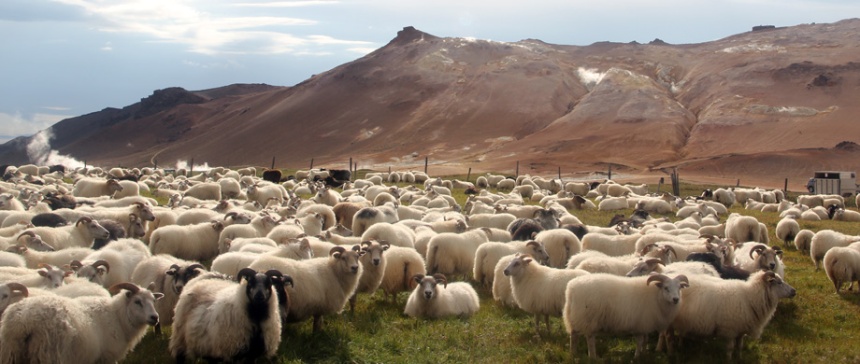
(Icelandic sheep)
4. You have worked with Icelandic sheep, and I wonder how this hands-on experience has influenced your approach to design, textiles and yarn production?
Nowadays we often know rather little where a product really comes from – we talked a bit together about the misleading ways yarn can be labeled, and all the unsaid information and hypocrisy that can go behind something that is described on the label as 100% wool, from a specific country. So yes, having worked with sheep, knowing how they are brought up, how they behave, how the wool is behaving and evolving on the living animal, how farmers are considering the wool and the sheep, what process it follows before it comes into perfectly wound skeins in the knitters hands, all this has certainly influenced my designs, trying to find the best use for the wool and to take advantages of its intrinsic qualities or defects. And then working with sheep and wool was certainly an excellent preparation for me to begin producing my own yarn! Of course I had not the slightest idea that this would be the case at the time!
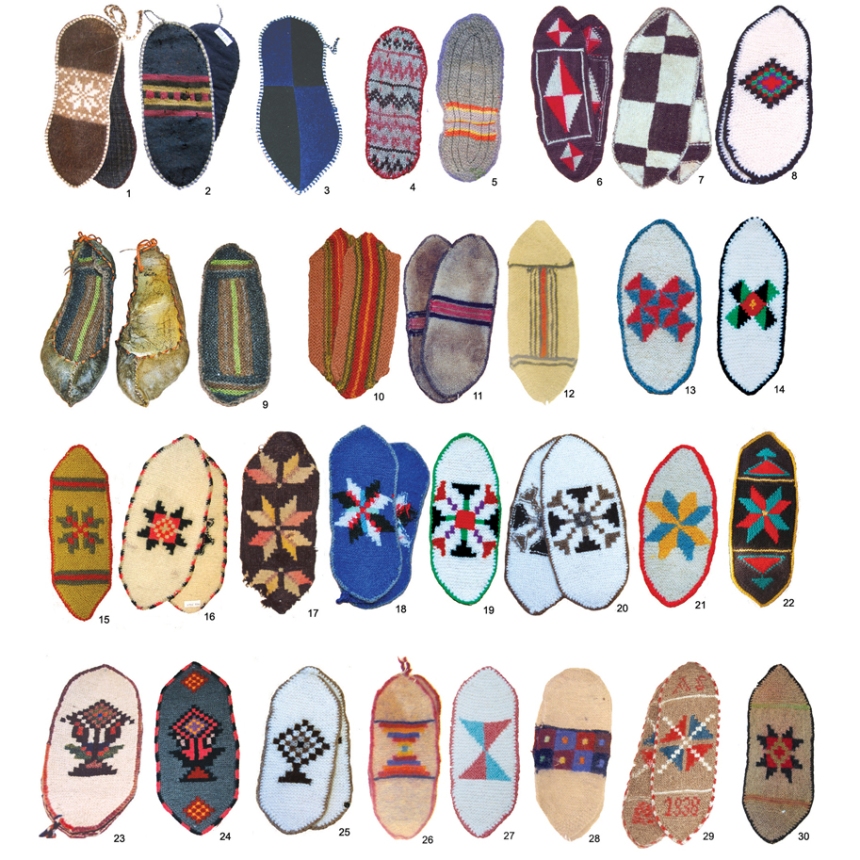
Icelandic shoe inserts, whose unique history and designs are explored by Hélène in Icelandic Knitting: Using Rose Patterns
5. Icelandic knitted shoe inserts are a wonderful example of how decorative textiles played a crucial role in the everyday lives of ordinary people. What first drew you to these remarkable objects?
In the sheep farm where I worked I was first given a little pair of shoes with tiny inserts inside. Later while studying textiles, I was asked to make a presentation about design in a particular research exercise, and I chose to work with knitting. I knew I wanted to explore something really typically Icelandic and remembered the inserts in the little shoes. I then asked the National Museum to open for me their shoe-inserts cabinet, and I fell in love with them – – so colorful, joyful, beautiful and also so graphic. I also think there is a modern aesthetic in the shoe inserts that immediately drew me to them. But they were worn to barely be seen, hidden under the foot. I want to think it made people feel good to be wearing something pretty even if the wearers were the only ones to know. It came as a surprise to me to find out how little opinion old people had on the shoe-inserts – souvenirs of harsh centuries of poverty and dependency – and how very little young people knew about them, if anything at all.
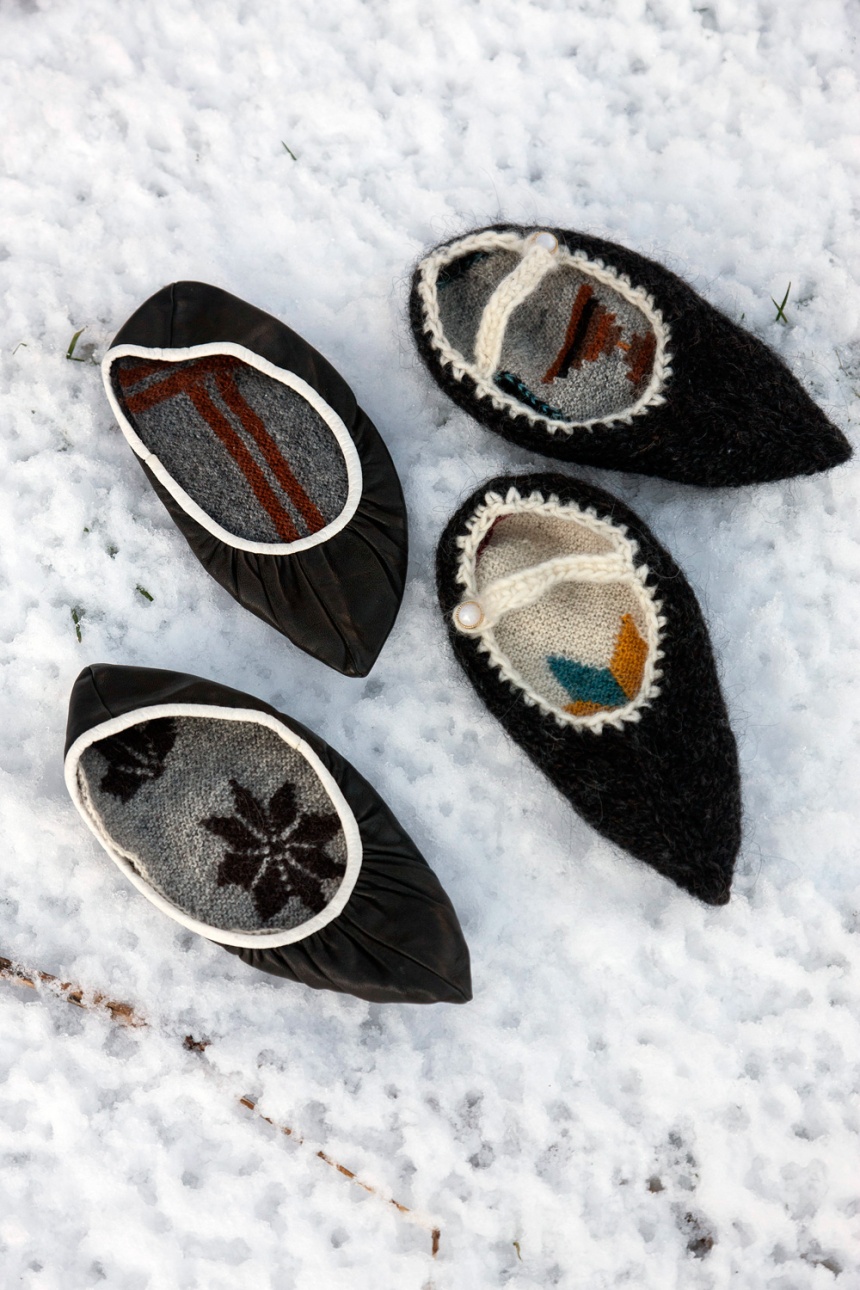
Icelandic soft shoes and shoe inserts from Icelandic Handknits
6. Your first book – Icelandic Knitting: Using Rose Patterns – is a tour-de-force of scholarly research combined with truly original knitwear designs. Can you tell us about the process of producing it?
In the research I carried out, I first presented the inserts not as utilitarian objects but as a collection of motifs that I classified by colors and patterns. This really impressed Guðmundur Oddur Magnússon (Goddur), the head graphic designer professor and he is the one who encouraged me to write my graduation essay about them. (He was actually the only academic who was interested in this aspect of my work — the Fashion department didn’t see the inserts with a very sympathetic eye). With his encouragement, I continued to explore further research on the subject. Having previously studied law was tremendously helpful when trying to locate scarce information on shoe-inserts somewhere in a pile of hand-written ramblings about how life was in the Old Days! But if I had to do it all over again – or if I had the time to return to student life – I’d much rather study textile history than law: I’m a bit envious of your skills! I then got a grant from the Student Innovation Fund to make new designs based on the inserts. My graduation fashion collection (despite the reluctance mentioned above) was inspired by the shoe-inserts. I kind of got completely obsessed with the shoe-inserts!

(Hammer Rose Vest from Icelandic Knitting: Using Rose Patterns)
What was crucial to me during the whole process was to show Iceland’s past and its traditions a lot of respect. First I wanted to record the traditions like they were and like they had evolved, so they wouldn’t get lost, but then I also wanted people to continue knitting after them, otherwise, they would simply die out! To this end, in the second part of the book, I designed garments and accessories all based on the inserts, using the techniques, working from the shape of the inserts or the shape of the motifs, keeping the colors like they were, playing with concepts, or the old sayings and stories that surrounded the inserts.

(Hélène wearing the Skautbuningur cardigan from Icelandic Handknits)
7 .My favourite design in your important second book – Icelandic Handknits: 25 Heirloom Techniques and Projects – is probably the Skautbuningur cardigan. To me this design encompasses many of the signature elements of your work: it combines a thoughtful interpretation of traditional costume, with the construction of the modern Icelandic yoked sweater; involves a really nifty technical trick for finishing the front bands and facings and is also a wonderfully wearable garment. Do you have a favourite design in this book?
Thank you Kate! That is always a tough question! There are designs I liked at the time but feel I could improve today, then there are designs that I enjoyed designing because there was an interesting construction or a solution to find or a concept to work around but that are not necessarily outstanding as such and finally there are the designs that I would like to knit for myself and wear! I actually do wear quite many of my handknits: I have the chance that Icelandic wool ages really well so even worn they are still presentable at tradeshows!
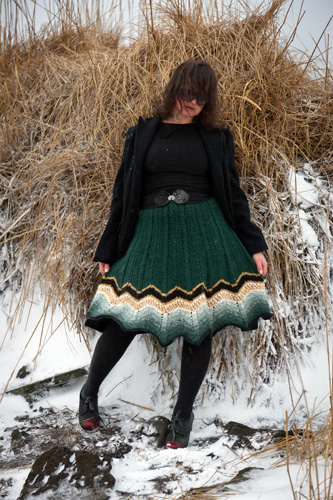
Klukka skirt from Icelandic Handknits
8. I love knitted undergarments and dresses and your Klukka- inspired design is another beautiful pattern in Icelandic Handknits. Could you tell us more about Icelandic Klukka and how they were made?
The klukka was a knitted slip, made of wool of course, worn by women under their clothes to keep warm. The body was often knitted with ribbing with and the skirt had an easy undulating lace pattern with stripes of colors enhancing the undulations. They could be handknitted but by the end of the 19th century/beginning of 20th century, many homes, where all the clothing was made, had knitting machines (like the one we saw in the fisherman’s house at the open Air Museum in Árbær). Klukka were, however often finished by hands with a little picot edge, which was crocheted or knitted.
9. And I understand that beautiful Icelandic lace dresses are the subject of your next book?
Yes, it was too bad you just missed by a couple of days the exhibition at the National Museum about the book process that I held for Design March!
While during researches on Icelandic knitting, I had come across a one article about an Icelandic woman who had been knitting lace dresses inspired by the traditional Klukka but much more intricate. It was always on the back of my mind to find out more about her and many years later, I decided to investigate and looked for the woman: she appeared to still be alive and accepted to meet me for an interview. After a couple of meetings, I thought that she and her work were so remarkable that I decided to write a whole book about her! It would be a terrible shame if her knowledge and expertise simply disappeared… She made one-of-a-kind dresses, but I include in the book patterns of some of her dresses and coats in multiple sizes. I’ve been working on it for a few years now. The most challenging part appeared to be the wool: the yarn she was using didn’t exist anymore and was much finer than the Einband from Istex, which is the only mill and the only Icelandic lace weight available (it’s close to fingering actually). Of course, I found some suitable yarns to knit the dresses, such as Shetland Supreme Lace 2 ply from Jamieson and Smith that you know well, but, without wanting to sound too dogmatic, I feel I OUGHT to use Icelandic wool as well!
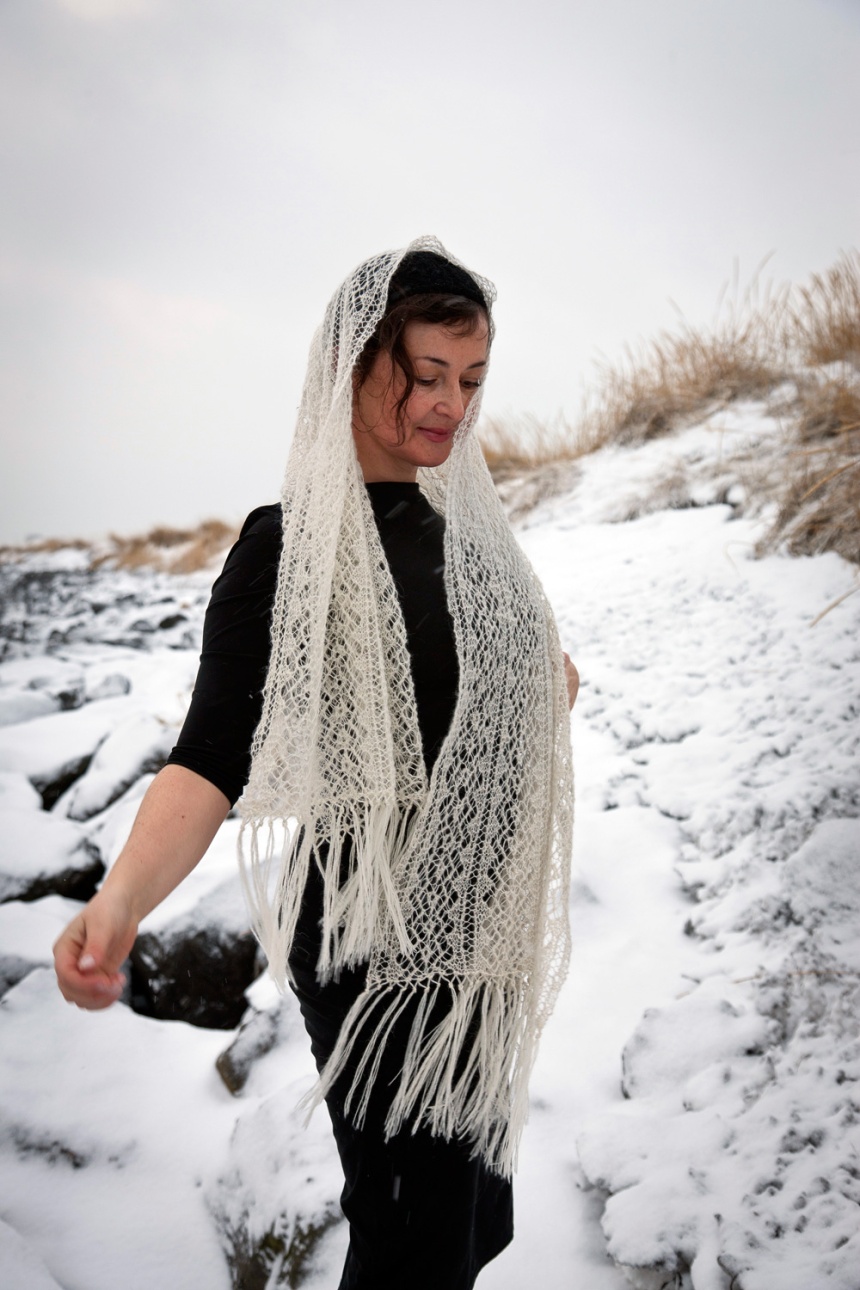
(Hélène’s Halldora design, from Icelandic Handknits, knitted with Love Story Artisanal 1 ply)
10. In conjunction with your research into Icelandic lace, I know you have been developing some very special laceweight yarn. Can you tell us more about your yarn experiments?
Yes, since there was no suitable Icelandic yarn for the dresses, I decided to make my own! I started making trials in a mini-mill in Belgium (there is no such thing as a mini-mill in Iceland so I sent selected wool abroad) and this is how Love Story Artisanal 1 ply was born. It is a beautiful fine lace-weight yarn made of high quality Icelandic wool, and very soft for an Icelandic yarn. Although it’s made by a machine, it is closer however to a handspun yarn. Because in a minimill you can work with small quantities at a time, I’m able to offer for sale many different shades of the natural Icelandic sheep colors as well as some plant-dyed colors. This artisanal production was very well received, and disappears very quickly. I find that I’m regularly out of stock and at the moment, I only have brown, black and white available… I can’t even imagine the complicated issues that would be involved with publishing a book recommending a yarn and not being able to keep up with the demand… So I’m heading for a bigger production for Love Story Artisanal 1 ply and that is easier to say than to do! Again I have turned to mills abroad since Ístex doesn’t have the capacity to make a finer lace. First there were many administrative obstacles to go through, one being that, despite all the campaigns for wool, unwashed wool is actually considered as an animal by-product by the EEC and goes by the same rules that meat carcass for shipping and handling… Then, it was not easy to find a mill that would be able to spin the Icelandic wool: it’s a very difficult wool to spin because of the mix of long and short hairs and a little challenging to make it into a fine regular lace. I sent wool here and there and was finally lucky to find a mill in Italy that had the confidence to make it: for the first trial, we made a one-ply but then decided to ply it so it would be more regular. . .
. . .and this is how my other yarn – called Grýla – was born: it’s a 2-ply yarn (Tvíband in Icelandic), made of 100% pure Icelandic wool, and is very sturdy and hardwearing (perfect for fine mittens for example!). It comes in 9 shades (that was the fun part for me choosing colors!) To go with it, I also made a Grýla Artisanal 2-ply in natural sheep colors: it’s spun at the mini-mill in Belgium with Icelandic lambswool and is really very soft. Grýla however is about the same weight as Ístex’s Einband so it is not terribly suitable for the lace dresses themselves (in fact that’s why it got the name of Grýla) but on its own terms it is a really lovely yarn! I knit my Icelandic Spring Shawl with it and it came out beautifully – I’ve also been working on a wee Grýla pattern collection that I will release in a few months.
. . . and now, I’m working on Love Story 2 ply, a yarn made of 100% Icelandic lambswool that will be absolutely perfect for the lace dresses! The lambswool being finer, it will be easier to make a finer yarn, also it’s much softer! I select high quality lambswool directly at Ístex washing station in Blönduós which is where the vast majority of farmers send their wool. I wanted first to buy it directly from the farmers but, though Ístex has been extremely cooperative and supportive of this project of mine, I still ran into many obstacles. As we speak, the wool is on its way to the mill in Italy: both white lambswool but also natural sheep colors, grey, brown and black. I can’t wait to see the end result but it will take a little while so we’ll all have to be patient!
11. You have a wonderful personal sense of style, Hélène, and I know that fashion was one of your previous scholarly interests. How (if at all) does contemporary fashion influence your current work?
Thank you Kate! I had two of my daughters while studying Textile design at the Iceland Academy of the Arts. While I was away on maternity leave for two years in a row (there’s only 16 months between them), the school undertook lots of changes and the Textile section was changed into a Fashion and Textile design section where the focus is on making a fashion line collection. So for this last year at school everything was new for me – it was a bit difficult with two babies a great learning experience for conveying ideas and make a coherent collection. During this last year at school, I also took all the basics courses in patterning, sewing, etc… I can’t say however I’m very much into following fashion at all! It all goes in a circle anyway… Still I’m probably influenced by my surroundings without noticing it!
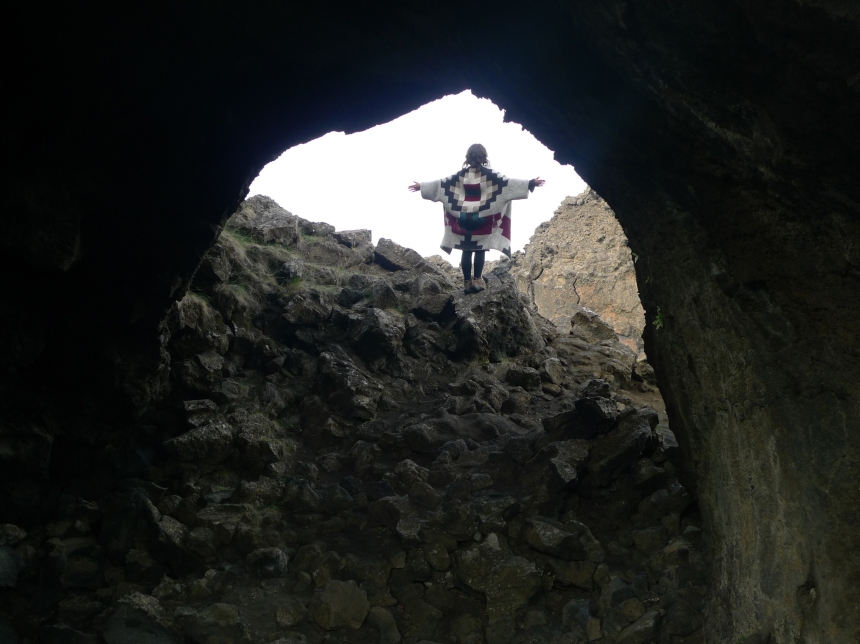
(Hélène in a stunning flowerpot coat of her own design)
12. With your tours, you are now introducing knitters all over the world to the landscape and culture of Iceland, as well as its textile history. Can you tell us about some of the locales and traditions you will be exploring on your tours in 2014?
I organise the knitting tours with Icelandic Mountain Guides-Iceland Rovers, a tour operator that I had already worked with as a mountain guide until I had my daughters (I had the 3 of them in just 4 years so there was no time then for guiding!). I design the tours and Mountain Guides see to all the practicalities (such as booking etc). My interest in Icelandic knitting heritage and my strong desire to share it and keep it alive, together with my experience as a mountain guide provides the impetus for these tours: they are designed to give an insight into Icelandic Culture and Knitting Traditions. Knitting is still today intrinsic to Icelandic culture, so discovering Iceland through the knitting will give you an immediate and really interesting insight into Icelandic Culture. The tours mix knitting with beautiful natural surroundings: we visit local museums and meet local people, knitters, spinners, dyers, designers, farmers. Each tour has its own way of exploring Icelandic knitting heritage, whether it´s by hiking, trekking or by short walks on a discovery adventure. The tours are also timed to coincide with the natural rhythms of the farming year, and explore several different themes associated with Icelandic culture and knitting.
For example, the Hiking and Knitting with the Elves tour in late June takes for its theme Icelandic lace and is takes place among the fjords of East Iceland where the queen of the Elves herself resides. Elven women were told to pass down from the Elven world to the by stepping onto their lace shawl that they laid down over a swamp. The interesting and distinctive characteristics of Icelandic lace often derive from the subtle colors, tones and shades that we can also see in the landscapes that we are crossing during the tour. June is also the season of flowering in Iceland, a perfect tine to collect plants for dying the delicate lace yarns. The tour includes a plant-dying workshop, we meet with an amazing local lace knitter and discover different types of lace made for example from handyed reindeer skin (reindeer live solely in east Iceland).
By contrast, The Enchanting North tour in July takes us through North Iceland to the fjord of Skagafjörður, the Textile Museum and the beautiful region of Mývatn. The hikes for this tour are pretty easy and accessible to the vast majority of participants and the tour gives a good overview of Icelandic landscape and knitting traditions. Additionally, we explore in some depth the Mittens traditions of Skagafjörður, which are distinctively and beautifully embroidered with and Old Icelandic cross-stitch.
After this, in August, one of my popular tours – Hiking and knitting between Fire and Ice – goes through the Fimmvörðuháls mountain pass, still hot after an eruption, at the foot of the now famous Eyjafjallajökull. This is probably the most challenging tour for the legs and feet and the theme of the tour is Icelandic footwear, especially the tradition of Icelandic shoe-inserts and Icelandic intarsia. Then in September the Spinning and knitting the Icelandic wool tour takes place. This is the time when sheep are gathered from the mountains (where they graze freely all summer), and sorted between farmers during round-ups. The tour take us through the whole process of working with Icelandic wool: rounding up and sorting the sheep, shearing, cleaning, combing, spinning, plant dying and finally knitting with the yarn that we create spun. We also visit the Istex mill factory and local spinners and dyers. Finally, in late October there is the last tour of the year: Knitting in the Magical Icelandic Night: the sheep are in the farm and the shearing season is beginning, we are knitting in cozyness of a turf farm guesthouse. It’s the beginning of winter and through this experience we get to understand how Icelandic wool kept the nation warm for centuries. At this time of the year, the sun hardly rises above the horizon, and the light is completely amazing. A bath in a hot spring, northern lights and colorful mittens are also on the program.
I also have a few custom tours made especially for groups of knitters or travel agencies and I’m already working on the program for 2015!

(Beautiful turf house at Glaumbaer)
13. In one way or another, you have been working with textiles and design in Iceland for almost fifteen years. Can you tell us something about the cultural shifts and changes you have observed in this field during this time?
I can clearly see a return to the roots and the prejudice against the past fade with the new generations. We talked a bit about it when you were here, regarding especially the turf houses, and you wrote an insightful post about it.
First there was the setting of Iceland Academy of the Arts and the construction of a Design and Architecture section. Although it may be still a bit early to tell, a definitive Icelandic design flair has emerged, bright and colorful and most of all full of energy.
The financial crisis is also a turning point to me. You can pretty much talk in terms of “before the crisis” and “after the crisis” to define an architecture design style. The before crisis being much show-off, a bit pretentious, expensive and big, often out of scale!

(Harpa in Reykjavik. The antithesis of vernacular architecture?)
14. You seem to me to be a natural designer and craftswoman: someone who simply has to be making something. If you had unlimited time (and resources) what would you most like to design and make?
Yes I pretty much feel I’m losing my time when I don’t make something with my hands! If I had enough time, first, it would not have taken me WEEKS to answer your interview questions! I would certainly spent more time on other crafts and show my daughters much more than I do now – I would also long be done with the Icelandic costume I’m making for myself at the Handicraft Association of Iceland! I would definitively publish more designs: I have patterns that have been ready to be published for 6 months or more and never seem to see the light. Would I produce more designs? Certainly, it’s not the ideas that are missing! – BUT in a way the limitation is also a garde-fou and forces you to make choices, to eliminate, to refine and keep only the essential. Still, a few hours more per day would do me only good!

(Hélène and her daughters at the sheep round-up)
Thank you so much for taking the time to tell us about your work and life, Hélène!

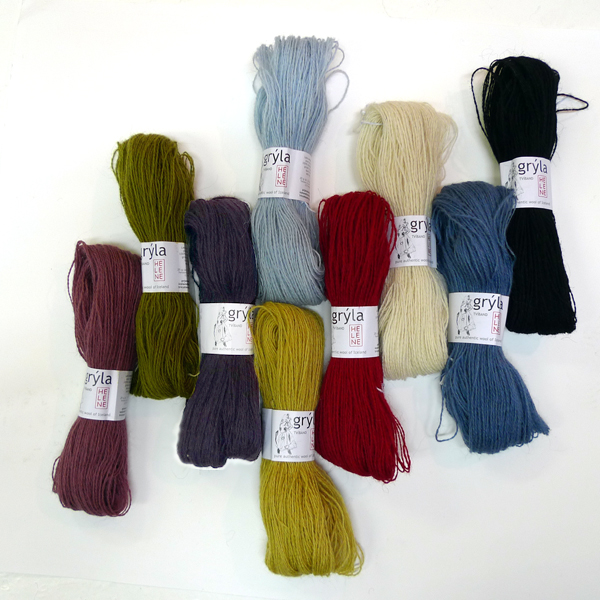



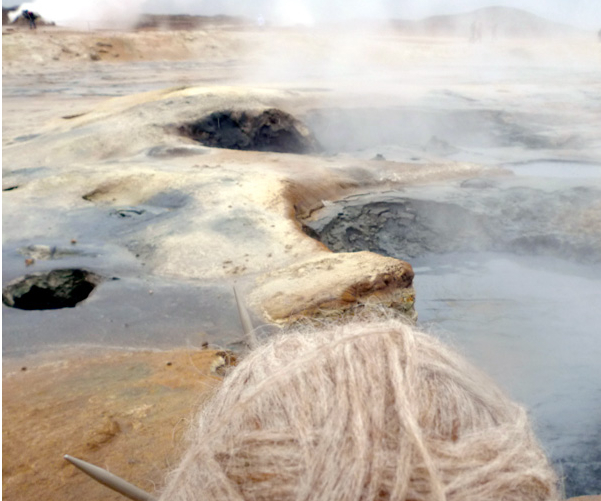
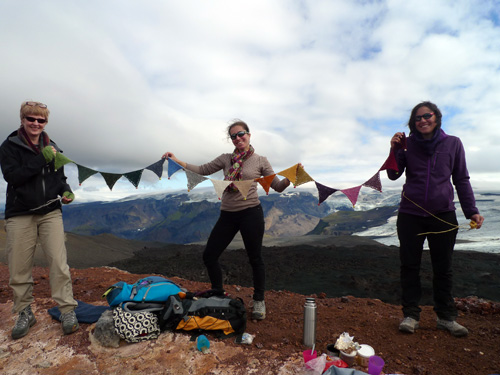
Loved reading this. Thank you. Do you know where the pattern can be found for the beautiful shawl near the end?
LikeLiked by 1 person
my breath is almost stopping with the magic of this article. Not only the extraordinary subject herself, her textile designs and her majestic landscape, but the genius of the writer who was able to find, draw out and show us all this beauty.
i know almost nothing about the history of textile design, but a glance at the shoe inserts suggests to me a commonality with first nation design in northern canada. Both eskimo and indian nation embroideries use arrowhead and star motifs – traditionally shown by quill and gut/hide – that date back thousands of years.
the landscape of Iceland, too, suggests the stark rocks of northern canada. On the other hand, the knitters – Helene and Kate – are matchless, i’m not sure we have their peers anywhere in north America!
i hadn’t realized Iceland is so far ahead in terms of fostering and nurturing its artisan/artist wool-based textile industry.
thank you Kate for an extraordinary article. I wish it were available as a PDF so it could be saved and kept forever.
LikeLike
gosh, i don’t know where to begin. starting with the first STUNNING photo, and the last with Hélène and her girls, there is so much to take in here, a brilliant interview. i love and appreciate all the research Hélène has put in to the history and tradition of icelandic knitting. i love the shoe inserts, Hélène’s books and patterns (i’ve made halldora shawl and rebecca), i LOVE the hiking trips and love story yarn (haven’t actually tried either of these, but someday!) thank you for all the effort put into making this gem of a post kate.
LikeLike
Thank you so much for sharing this wonderful interview along with the photos. I loved reading it this morning.
LikeLike
breathtaking
both the visuaLs
and the interview
x x x x x thank you
LikeLike
Very cool!
LikeLike
I enjoyed this so much, dear Helene and Kate. Thank you!
And I would like to go on every single one of those hikes – most particularly the winter one. When Helene described the amazing light of those days with the sun barely over the horizon, I could instantly see it all in my mind and it took my breath away.
LikeLike
I so much enjoyed your interview with Helene – how many of us wander before we know where we truly belong…..
LikeLike
What a fabulous interview and stunningly inspiring artist. Iceland is truly amazing (physically and culturally) and I loved reading this post. Thank you:)
LikeLike
Thank you so much for traveling. I want to go to Iceland. It is on my list. You take great pictures. i enjoyed reading this post.
LikeLike
Oh my Goodness! You lucky woman! (Well, I think you were both lucky to meet each other.) Thank you for letting us be a fly on the wall for some of your conversation. So much wonderful information here, I’m sure I will need to re-read this interview again to do it justice. Ever since I came across her first book years ago, I have been enchanted by, as you point out, her unique style and sense of creativity. I’m so thrilled to see her yarn here, and I’m so glad you shared this with us.
LikeLike
What an interesting, delightful and informative conversation, with super photos! Thoroughly charming and inspiring!
LikeLike
Once again, Kate, thanks for sharing this great interview with Helene. What a joy to be such an armchair traveler!
LikeLike
I got to see the Love Story yarn and Hélène’s dresses at the National Museum! They were gorgeous!
LikeLike
Thank you, Kate and Helene! That was a fascinating interview. I love the last photograph, especially.
LikeLike
What a wonderful post! I enjoyed every bit of it.
LikeLike
OMG, what a stunning delightful post! Thank you both for your time and talents!! Lovely.
LikeLike
What an interesting post!! Thanks so very much for the pictures, the interview, Helene, just very enjoyable!!
LikeLike
Oh, how I love knitters and wool and colors! And what an interesting glimpse into Helene’s progression from lawyer to mountain guide to knitwear designer. I bought her book Icelandic Knitting Using Rose Patterns because of the Second Eight-Petal Rose Sweater. It’s on my someday-when-I-stop-avoiding-intarsia list.
LikeLike
A thrilling interview! Thanks so much for bringing it to us.
LikeLike
Wow, what a great interview. Now one of the Iceland knitting tours is on my bucket list! I luv the history you always bring to your posts.
LikeLike
Thank you for this great post. I know nothing about Iceland but I found your interview along with fantastic photos really interesting.
LikeLike
Thank you for sharing this and the inspiration! Hopefully, maybe…. one day a journey to Iceland and Shetland! Falling for both and their textiles :-)
LikeLike
Great interview. I love the pictures so lovely. I am a fan of Helene’s designs as well. Thx for sharing.
LikeLike
Awe inspiring in every way. Thank you for this post !
LikeLike
I love Helene’s answer to question three. That love of the landscape where she feels she belongs seems to be at the very heart of her approach and design. Wonderful.
LikeLike
What a fabulous interview, Thank you, both!
LikeLike
Thank you for this post. I fell in love with Iceland last October on a knitting tour. I want to save up and return to that beautiful place someday. I have Helene’s first book based on the rose patterns. The vest is my favorite.
LikeLike
Does anyone go to Iceland and not fall head over heels with the beauty of it? I love it so. The interview with Helénè is fantastic, I love the idea of an Icelandic lace dress. Beautiful.
LikeLike
I am a devoted Shetland knitting fan so it good to take a look outside that envelope.
LikeLike
Very inspiring, and thank you for sharing :) Iceland sounds amazing!
LikeLike
Another great blog post, Kate, and a new author to add to my wishlist of books…inspiring photographs and stories…
LikeLike
I love the colours of Gryla. On my screen the little shoes were adjacent to an Instagram picture of Bruce with one of his gloves, and I almost got worried for them…
LikeLike
Lovely interview, and I appear to have bought a book (it was the klukka skirt that did it)
LikeLike
Thank you for this, both of you. Iceland, some day………. :)
LikeLike
Wonderful interview, spectacular photos and stunning projects! Thank you so much for the very enjoyable post today!
Best,
Sheila
http://sheilazachariae.blogspot.com/2014/05/off-hooksummer-shawl.html
LikeLike